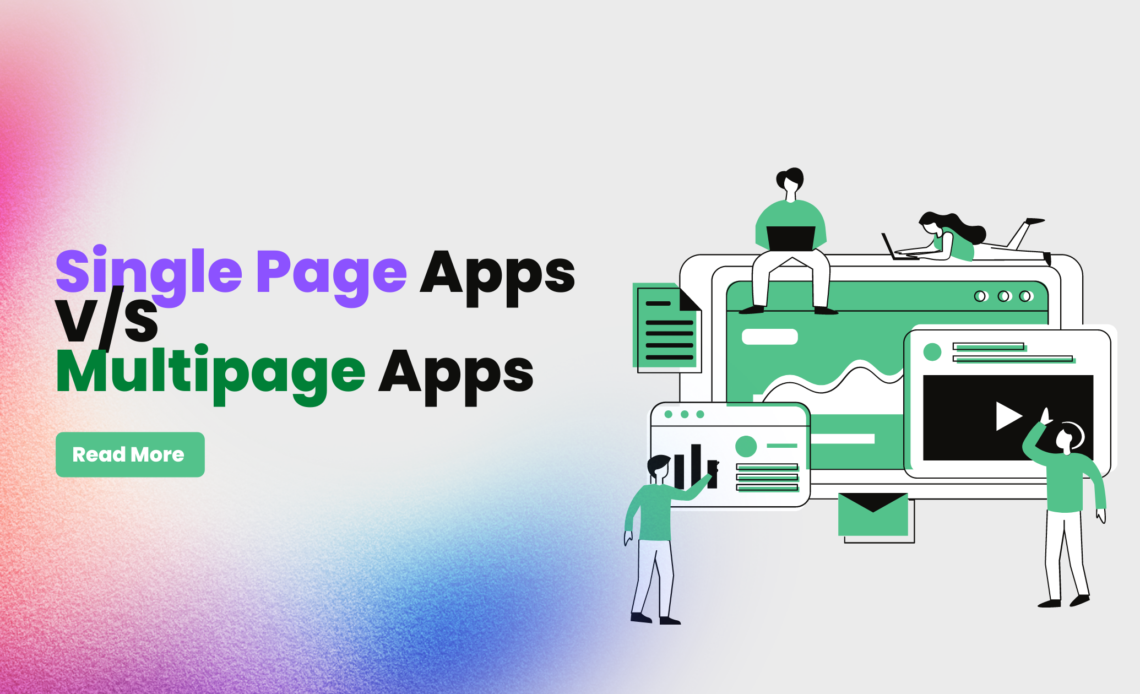
As web development technology continues to evolve, the debate between Single Page Applications (SPAs) and Multiple Page Applications (MPAs) has become increasingly relevant. Both options have their own set of advantages and disadvantages, and the choice of which to use depends on the specific needs of the project. In this article, we will explore the key differences between SPAs and MPAs, and help you decide which approach is best for your next web development project. Read more about the difference between Single Page Application vs Multiple Page Application.
What is a Single Page Application?
A Single Page Application (SPA) is a web application that loads a single HTML page and dynamically updates that page as the user interacts with the application. This is in contrast to a traditional Multiple Page Application (MPA), which reloads the entire page each time the user navigates to a new page.
The top features of a single page application (SPA) include:
- Dynamic Content: A SPA can dynamically update the content of a web page without requiring a full page refresh.
- Improved Performance: Because a SPA only needs to load a single HTML page and dynamically update the content, it can have improved performance compared to traditional multi-page applications.
- Offline Capability: With the use of service workers, a SPA can work offline or with a poor network connection.
- Improved User Experience: By providing a more seamless and responsive experience, a SPA can improve the overall user experience.
- Responsive Design: A SPA can be designed to be responsive to different screen sizes and devices.
- Easy Navigation: A SPA can provide easy navigation within the application through the use of client-side routing.
- Reusable Code: A SPA can re-use code for different sections of the application, which can make development more efficient.
- Cross-Platform: A SPA can be developed to run on different platforms, such as web, mobile, and desktop.
Advantages of SPAs
- Faster User Experience: SPAs offer a faster and more seamless user experience, as they don’t require the browser to reload the entire page each time the user navigates to a new page. This can result in a more responsive and fluid user interface.
- Lower Server Load: With SPAs, the majority of the application logic runs on the client-side, which reduces the load on the server. This can lead to better performance and scalability.
- Better Caching: SPAs can cache the majority of the application code on the client-side, which can reduce the number of requests to the server and improve load times.
Disadvantages of SPAs
- SEO Challenges: SPAs can be more challenging to optimize for search engines, as the dynamic content is generated on the client-side, and not visible to search engine crawlers.
- Limited Browser Support: Some older browsers may not support the technologies used to build SPAs, which can limit the potential audience for the application.
What is a Multiple Page Application?
A Multiple Page Application (MPA) is a traditional web application that loads a new HTML page each time the user navigates to a new page. This is in contrast to a Single Page Application (SPA), which dynamically updates a single HTML page.
The top features of a Multi page application (SPA) include:
- Server-side Rendering: MPAs rely on the server to generate and render the HTML, which can improve the initial load time for the application.
- Improved Search Engine Optimization (SEO): Because the HTML is generated on the server, search engines can more easily index the content of an MPA.
- Easy to Scale: MPAs can be easily scaled by adding more servers to handle increased traffic.
- Better Security: The server-side nature of MPAs can make them more secure, as sensitive information can be kept on the server and not exposed to the client.
- Better Support for Legacy Browsers: MPAs can be more compatible with older browsers that may not support modern JavaScript features.
- Better support for caching: MPAs can be cached by CDN or browser, which can improve the load time.
- Better support for different languages: MPAs can be developed using different languages, such as PHP, Ruby, Python, and Java, which can make it easier to find developers with the necessary skills.
- Better support for testing: MPAs can be tested more easily, as the server-side and client-side code can be separated and tested separately.
Read More on: Domain Dossier : A Comprehensive Guide
Advantages of MPAs
- Easier SEO: MPAs are typically easier to optimize for search engines, as each page has its own unique HTML content that can be indexed by search engine crawlers.
- Better Browser Support: MPAs tend to have better browser support, as they don’t rely on the latest technologies and can be accessed by a wider audience.
- Simpler Development: MPAs are often simpler to develop and maintain, as they don’t require the use of complex client-side libraries and frameworks.
Disadvantages of MPAs
- Slower User Experience: MPAs can offer a slower user experience, as the browser needs to reload the entire page each time the user navigates to a new page.
- Higher Server Load: With MPAs, the majority of the application logic runs on the server-side, which can increase the load on the server and lead to poor performance and scalability.
Conclusion
In conclusion, both SPAs and MPAs have their own set of advantages and disadvantages, and the choice of which to use depends on the specific needs of the project. SPAs offer a faster and more seamless user experience, but can be more challenging to optimize for search engines. MPAs are typically easier to optimize for search engines, but can offer a slower user experience.
Frequently Asked Questions on Single Page Application V/s Multipage Application
What is the main difference between a single page application (SPA) and a multi-page application (MPA)?
The main difference is that SPAs load a single HTML page and dynamically update the content, while MPAs generate new HTML pages on the server with each request.
Which one is better for performance?
SPAs can have better performance as they only need to load a single HTML page and dynamically update the content, while MPAs require a new HTML page to be generated and loaded with each request, which can add to the load time.
Which one is better for search engine optimization (SEO)?
MPAs can be better for SEO as the server generates the HTML and search engines can more easily index the content, while SPAs rely on JavaScript to dynamically update the content, which can make it more difficult for search engines to index.
Which one is better for security?
MPAs are generally considered to be more secure as sensitive information can be kept on the server and not exposed to the client, while SPAs rely on client-side JavaScript and can make it more difficult to keep sensitive information secure.
Which one is better for offline capability?
SPAs can be designed to work offline through the use of service workers, while MPAs rely on a connection to the server to function and may not work offline.
Which one is better for development?
Both SPAs and MPAs have their own strengths and weaknesses and the choice will depend on the specific requirements of the project and the skill set of the development team.
Can an MPA be converted to a SPA?
Yes, an MPA can be converted to a SPA by re-architecting the application to use client-side routing and dynamic updates instead of server-side rendering.
Can you use both SPA and MPA in the same application?
Yes, it is possible to use both SPA and MPA in the same application, depending on the requirements of the project and the use case. For example, you can use a SPA for the front-end and an MPA for the back-end or you can use MPA for some pages and SPA for the rest of them.
Is SPA a better choice for mobile app development?
SPA can be a good choice for mobile app development, as it can provide a more seamless and responsive experience, and can be designed to be responsive to different screen sizes and devices.




